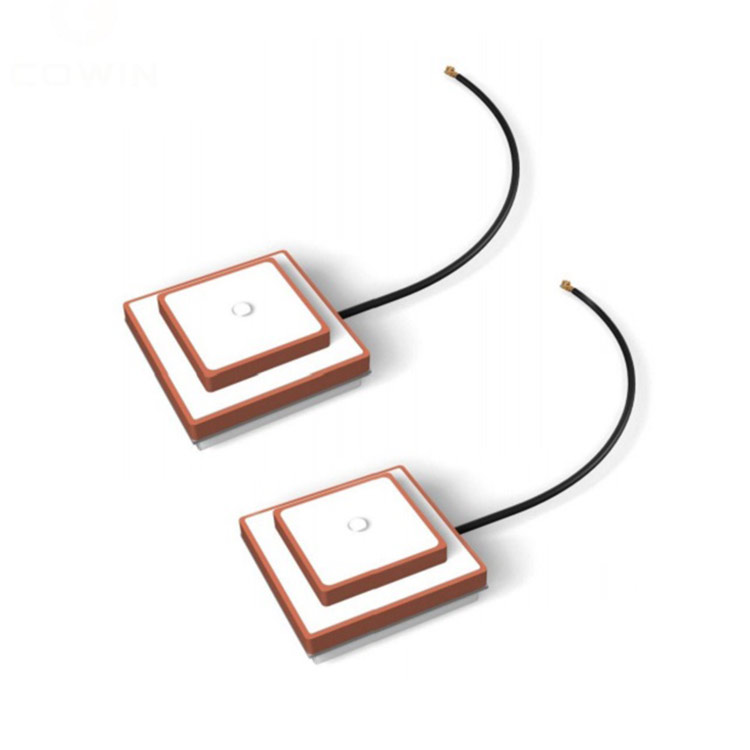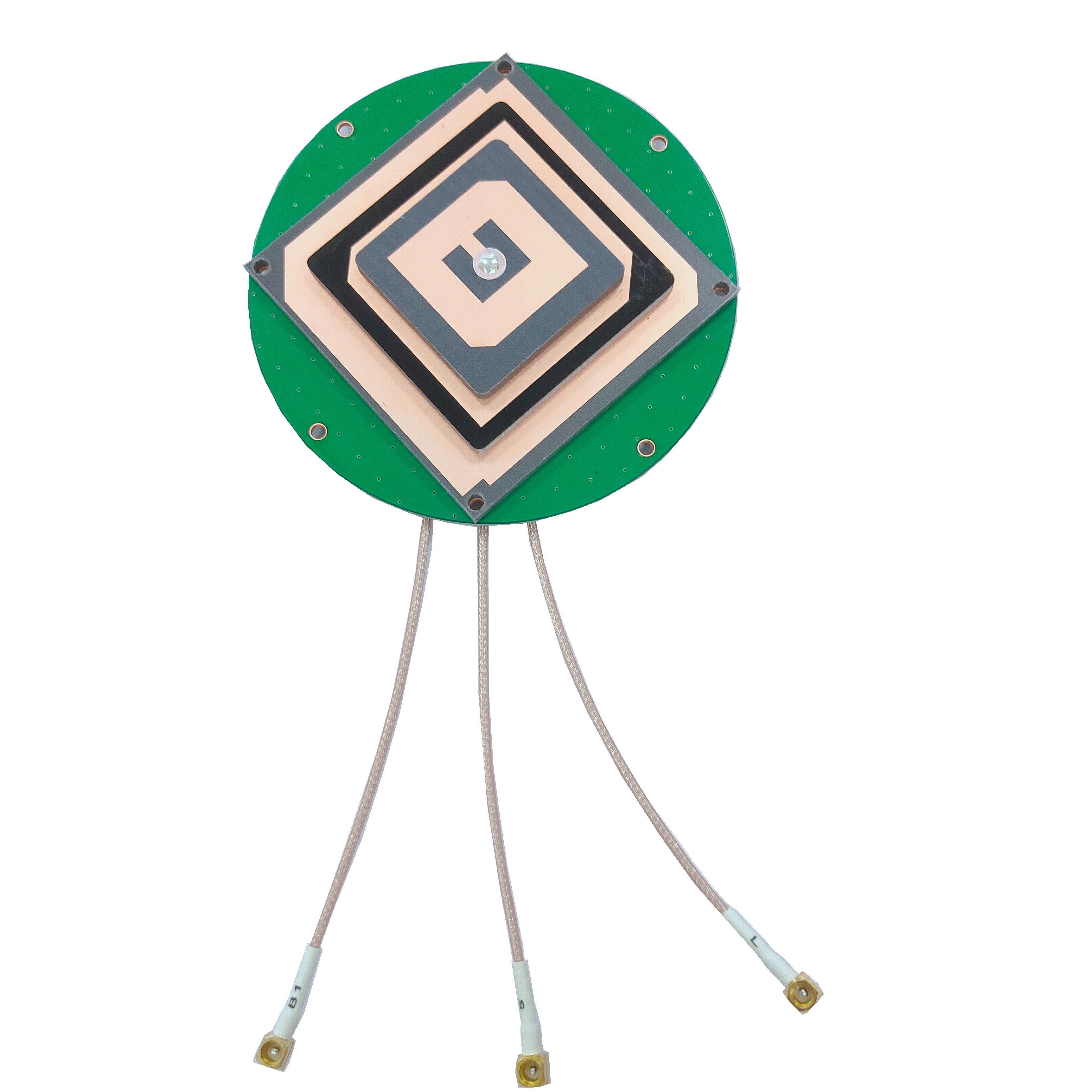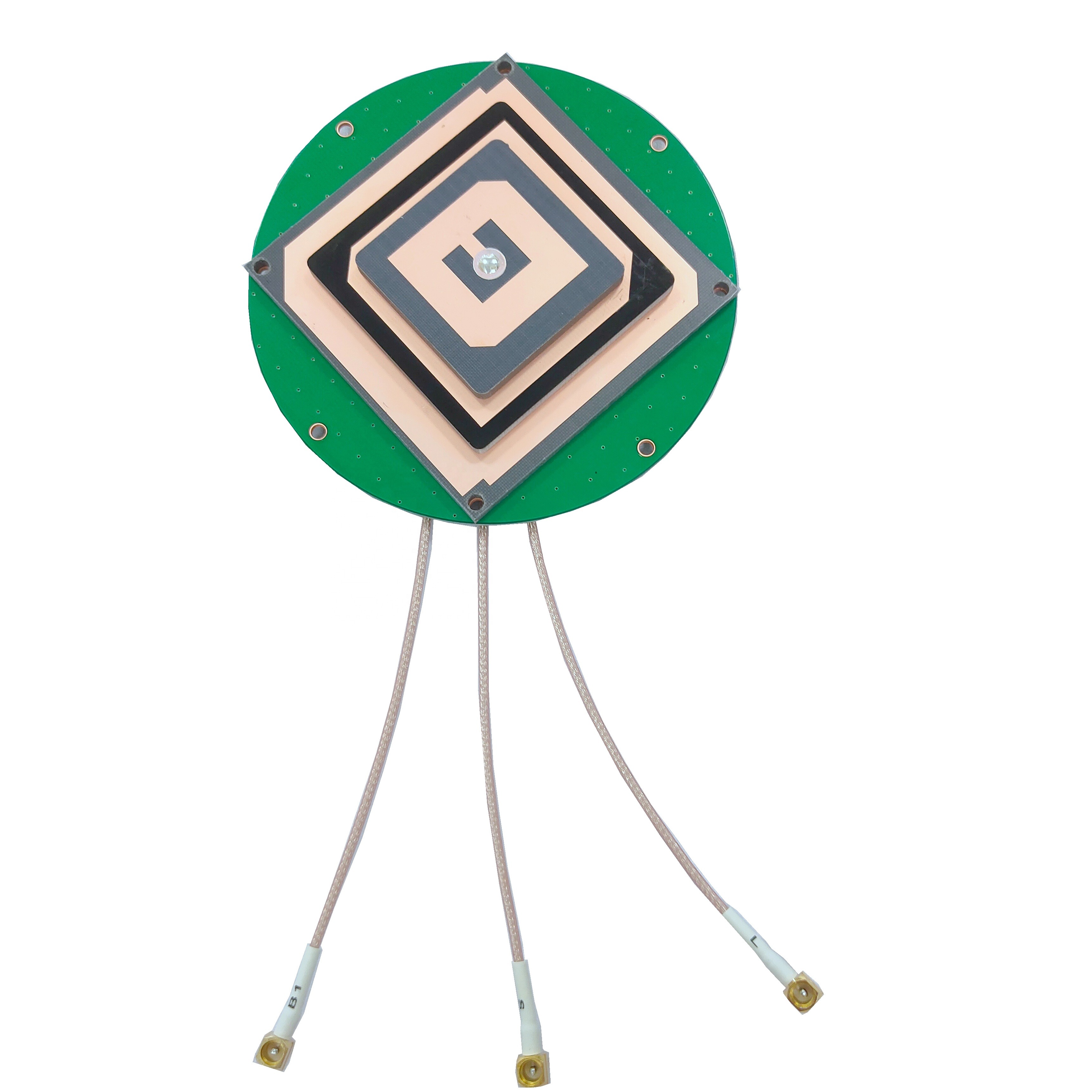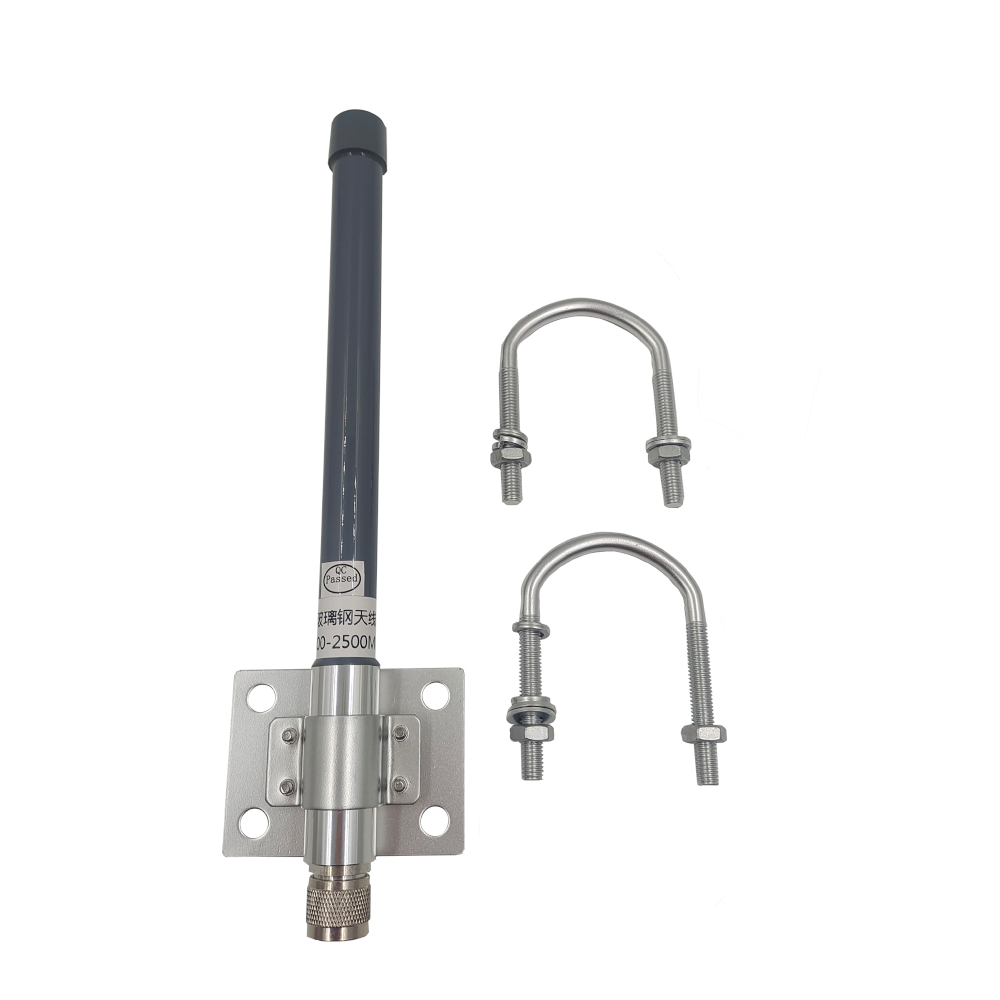overview
An embedded GNSS antenna is fundamentally different from its external counterparts. It is not a discrete, connectorized component but is instead integrated directly into the printed circuit board (PCB) of a host device, such as a smartphone, wearable tracker, drone, automotive telematics unit, or IoT sensor. This integration represents a triumph of miniaturization and electromagnetic engineering, sacrificing neither form nor function but rather redefining both to meet the constraints of modern consumer and industrial design.
The primary mission of any GNSS antenna is to receive ultra-weak radio frequency signals transmitted from constellations of satellites orbiting the Earth, including GPS (USA), GLONASS (Russia), Galileo (EU), and BeiDou (China). These signals, in the L-band frequency range (primarily 1.57542 GHz for GPS L1), have traveled over 20,000 kilometers and are astonishingly faint by the time they reach the Earth's surface. The antenna's role is to act as an efficient "collector" for this energy, providing gain and delivering the signals to a GNSS receiver chip with minimal loss and distortion. The receiver then processes these signals to calculate precise time and location.
The challenge of embedding this functionality is profound. Unlike an external antenna with a clear view of the sky, an embedded antenna must operate within the "electronic jungle" of a device's housing. Its performance is heavily influenced by its immediate environment: the PCB itself acts as a ground plane (often imperfect), nearby components can cause interference or detuning, and the device's casing can attenuate or reflect signals. Furthermore, the device is often held or used in ways that can block the signal path, such as a hand covering a smartphone's antenna location.
The advantages of successful embedding, however, are transformative. It enables sleek, compact, and waterproof product designs without external protrusions. It reduces the Bill of Materials (BOM) cost by eliminating connectors, cables, and separate housing. It simplifies assembly through automated PCB population, making it ideal for high-volume manufacturing. This has democratized access to high-precision location data, embedding it into devices of all price points and purposes.
The applications are ubiquitous. From guiding emergency services to a caller's location and enabling turn-by-turn navigation on a phone, to tracking valuable assets across the globe and synchronizing financial trading networks with nanosecond precision, the embedded GNSS antenna is an unsung hero. It is the enabling technology for the sharing economy (e.g., ride-hailing), personal fitness tracking, precision agriculture, and the future of autonomous systems.
In summary, the embedded GNSS antenna is a masterpiece of compromise and innovation. It represents the ongoing effort to shrink powerful RF functionality into an invisible, low-cost, and robust form factor. It is the critical link that translates the vast, global infrastructure of satellite constellations into a personal, portable, and pervasive utility, making location awareness a seamless and indispensable part of our daily lives.
Design and Construction
The design and construction of an embedded GNSS antenna is a complex interdisciplinary endeavor, blending electromagnetic theory, materials science, and mechanical engineering to create a component that performs reliably within the hostile and confined environment of a consumer electronic device. This section deconstructs the antenna, exploring the materials, architectures, and trade-offs that define its form and function.
The Radiating Element: Patched into Reality
The most common type of embedded GNSS antenna is the Microstrip Patch Antenna. This design consists of a flat, conductive element (the "patch") etched onto a dielectric substrate, which is mounted over a larger ground plane. This structure is resonant at the target GNSS frequency.
Materials: The substrate is a critical choice. Standard FR-4 PCB material is often used for cost-sensitive applications, but its high dielectric loss and temperature instability can degrade performance. For higher performance, specialized low-loss laminate materials like Rogers RO4003 or Taconic TLY are used. These materials offer stable dielectric constants and lower loss tangents, which translate to better efficiency and bandwidth.
Feeding Techniques: The patch must be excited by a feedline. Common methods include:
Probe Feed: A coaxial connector's inner conductor is soldered directly to the patch through the substrate.
Microstrip Line Feed: A conductive trace from the RF output is connected directly to the edge of the patch.
Aperture-Coupled Feed: The patch is fed electromagnetically through a slot in the ground plane from a microstrip line on a separate layer. This provides good isolation and bandwidth but is more complex.
Ceramic Patch Antennas: The Performance Standard
A highly popular variant is the ceramic patch antenna. This is a pre-fabricated component where the patch is printed on a block of ceramic material with a very high dielectric constant. This allows the antenna to be made physically very small while remaining electrically resonant at the target frequency. These modules often include a built-in Low-Noise Amplifier (LNA) and are simply soldered onto the host PCB as a single component, simplifying design and integration.
Planar Inverted-F Antenna (PIFA): The Space-Saver
Another common design is the PIFA. It is a popular choice for mobile phones due to its low profile and good bandwidth. The PIFA is essentially a shorted patch antenna, where a plate is mounted above a ground plane, short-circuited at one end, and fed at an intermediate point. This design is more compact than a full patch but can be more sensitive to its surrounding environment.
The Critical Role of the Ground Plane
In embedded antenna design, the ground plane is not just a reference; it is an active part of the radiating system. The PCB's ground plane serves this purpose. Its size and shape are crucial. A larger ground plane typically results in better performance and a more predictable radiation pattern. A major design challenge is optimizing antenna performance on a small or irregularly shaped ground plane, which is common in compact devices.
The Integration Challenge: The Hostile Environment
Designing the antenna in isolation is only half the battle. Integrating it into a device presents significant challenges:
Component Proximity: Nearby batteries, displays, cameras, and metal shields can detune the antenna, shifting its resonant frequency and degrading its performance. Careful placement and electromagnetic simulation are required.
Human Interaction: The device will be held, carried, or placed on surfaces. The human body is mostly water, which is highly absorbent of RF energy at GNSS frequencies. Designers must anticipate this "hand effect" and often use multiple antennas or diversity techniques to mitigate it.
Housing Effects: The plastic or glass device casing can affect performance. Metalized coatings for aesthetics or EMI shielding can be catastrophic, creating a Faraday cage that blocks all signals. Designers must leave "antenna windows" free of conductive materials.
Active vs. Passive Antennas
Passive Antennas: These are just the radiating element. They are lower cost but provide no signal amplification. The weak signal is susceptible to loss in the transmission line to the receiver.
Active Antennas: These incorporate a Low-Noise Amplifier (LNA) located extremely close to the radiating element. This amplifies the weak satellite signal before any significant loss occurs, dramatically improving the system's signal-to-noise ratio (SNR) and sensitivity. Most high-performance embedded antennas are active, receiving power (typically 3.3V) from the receiver via the RF coaxial cable.
Construction and Assembly
The final construction involves precise automated soldering (e.g., reflow soldering) onto the main PCB. The antenna must survive this high-temperature process without deformation or detuning. The entire assembly is then housed within the device, with the antenna's performance ultimately validated through rigorous testing in an anechoic chamber to measure its radiation pattern, efficiency, and gain.
In conclusion, the design and construction of an embedded GNSS antenna is a delicate balancing act. It involves squeezing maximum performance from a minimal footprint while battling the detuning effects of its own host device. It is a field where advanced simulation software is as important as the soldering iron, and where success is measured in decibels of gain and millimeters of size.
Working Principles
The operation of an embedded GNSS antenna is a remarkable feat of capturing incredibly faint signals from a rapidly moving source amidst a sea of electronic noise. Its working principles are defined by the physics of electromagnetic wave reception, the constraints of its embedded environment, and the need to provide a clean signal to the receiver for processing.
The Signal from Space: A Faint Whisper
GNSS satellites transmit spread-spectrum signals in the L-band (~1.5-1.6 GHz). After traveling over 20,000 km, these signals arrive at the Earth's surface with a power level as low as -130 dBm—literally billions of times weaker than a received cell phone signal. They are effectively "below the noise floor," meaning their power is lower than the inherent thermal noise in the environment. The antenna's first job is to provide passive gain, effectively acting as a larger "aperture" to collect more of this weak signal energy than a simple point could.
Resonance and Reception
The antenna is designed to be resonant at the target GNSS frequencies (e.g., 1575.42 MHz for GPS L1). At resonance, the antenna's impedance is matched to the input impedance of the receiver (typically 50 ohms), allowing for maximum power transfer. When the electromagnetic wave from a satellite impinges upon the antenna's conductive element, it induces a tiny, oscillating electrical current. The geometry of the patch or PIFA is optimized to make this process as efficient as possible at the desired frequencies.
The Imperative of Circular Polarization
GNSS signals are transmitted using Right-Hand Circular Polarization (RHCP). The embedded antenna must be designed to be sensitive to RHCP waves. This is crucial because signals reflected off the ground, buildings, or other surfaces undergo a polarization shift, typically becoming Left-Hand Circular Polarized (LHCP). The antenna's inherent preference for RHCP makes it less receptive to these reflected, multipath signals, which are a primary source of positioning error. This is the first line of defense in ensuring accuracy.
The Role of the Low-Noise Amplifier (LNA)
In an active antenna, the tiny electrical current induced by the satellite signal (measured in microvolts) is immediately fed into an LNA. The LNA's purpose is twofold:
Amplify the Signal: It boosts the signal's power by a significant factor, typically 15-30 dB.
Introduce Minimal Noise: It is designed to add as little electronic noise of its own as possible (a key metric is its Noise Figure). A good LNA amplifies the signal while preserving a favorable Signal-to-Noise Ratio (SNR).
This amplification at the source is critical because the signal must then travel through a trace on the PCB to the receiver chip. Any trace has inherent loss; amplifying the signal first ensures that what arrives at the receiver is still strong enough to be decoded, even after these losses.
Overcoming the Embedded Environment
The antenna's performance is heavily influenced by its surroundings:
The Ground Plane: The PCB's ground plane is part of the antenna's structure. It helps to create the antenna's radiation pattern, directing gain towards the sky and providing a degree of front-to-back ratio to reject signals and noise coming from below the device (e.g., from the circuit board itself).
Pattern Distortion: Unlike an ideal antenna in free space, an embedded antenna has a distorted, often irregular radiation pattern due to the nearby components and housing. The goal is not a perfect pattern but a "good enough" pattern that can see a sufficient number of satellites in most orientations.
Desensitization: Aggressors like cellular transmitters (4G/5G), WiFi radios, and display drivers can generate strong in-band noise that can "desense" (desensitize) the highly sensitive GNSS receiver. Careful board layout, shielding, and filtering are required to protect the GNSS signal path.
The Path to a Position Fix
The amplified signal is delivered to the GNSS receiver IC via a controlled-impedance microstrip trace on the PCB. The receiver then performs the complex tasks of correlation, demodulation, and navigation solution calculation. The quality of the signal provided by the antenna—its strength, SNR, and purity from interference—directly determines how quickly and accurately the receiver can acquire satellite signals and compute a position fix.
In essence, the working principle of an embedded GNSS antenna is to act as a highly specialized, miniaturized, and environment-aware signal collector. It is engineered to pluck a specific, faint, polarized whisper from a cacophony of noise and interference, amplify it faithfully, and deliver it to the digital brain of the receiver, enabling it to perform its magic of calculating a precise location from the timing of signals from moving stars.
Advantages and Challenges
-
The adoption of embedded GNSS antennas offers a compelling set of benefits that have driven their proliferation across countless devices. However, reaping these rewards requires successfully navigating a series of significant technical and design challenges that are inherent to their miniaturized and integrated nature.
Advantages
Form Factor and Aesthetics: The primary advantage is the enablement of sleek, compact, and minimalist product designs. There are no external protrusions, cables, or connectors, allowing for seamless and aesthetically pleasing integration into smartphones, wearables, and other consumer devices.
Cost Reduction at Scale: Eliminating external components like connectors, cables, and separate housings reduces the Bill of Materials (BOM). Furthermore, the antenna can be assembled onto the PCB using standard automated Surface-Mount Technology (SMT) processes, streamlining manufacturing and reducing labor costs, especially in high-volume production.
Enhanced Reliability and Robustness: An embedded antenna has no moving parts and no external cables that can be damaged, snagged, or disconnected. Once soldered to the board and encapsulated within the device, it is highly resistant to physical shock, vibration, and wear-and-tear. This also simplifies the design of waterproof and dustproof (IP-rated) devices.
Design Flexibility: While placement is critical, designers have some freedom to position the antenna within the device to optimize for available space and avoid other components. Ceramic patches can be placed on the top side of the PCB to get a clearer "view" of the sky.
Ideal for Mass Market Applications: The combination of low cost, small size, and high reliability makes embedded antennas the perfect solution for the consumer electronics market, where these factors are paramount.
Challenges
Performance Compromise: This is the most significant challenge. Performance is almost always inferior to a well-designed external antenna with a clear view of the sky. The constraints of size, limited ground plane, and hostile nearby components lead to lower gain, reduced efficiency, and distorted radiation patterns. This can result in longer Time-To-First-Fix (TTFF), lower accuracy, and poorer performance in challenging environments like urban canyons or under dense foliage.
Integration Complexity and Detuning: The antenna's performance is critically dependent on its integration environment. The proximity of batteries, displays, metal shields, and even the user's hand can detune the antenna, shifting its resonant frequency and degrading its impedance match. This requires extensive electromagnetic simulation (e.g., using HFSS or CST) and empirical testing in the final product form factor, adding time and cost to the design cycle.
Electromagnetic Interference (EMI): The device itself is a major source of noise. Cellular, WiFi, Bluetooth, and power management circuits can all generate RF noise that falls within the GNSS band. This noise can radiate and be picked up by the GNSS antenna, desensitizing the receiver. Mitigating this requires careful PCB layout, strategic shielding, and the use of filters, such as Surface Acoustic Wave (SAW) filters in the RF line.
The "Hand Effect" and User Blockage: The user's body is a significant attenuator of RF signals at GNSS frequencies. How a device is held (e.g., covering the antenna location on a phone) can dramatically reduce signal strength, leading to dropped fixes. Designing around this often requires diversity schemes (multiple antennas) or intelligent algorithms that can switch to the antenna with the best signal.
Thermal Effects: Components heat up during operation. The dielectric properties of PCB materials and ceramics can change with temperature, causing the antenna's resonant frequency to drift. This must be characterized and compensated for in the design to ensure stable performance across the device's operating temperature range.
Standardization and Supplier Lock-in: Unlike standardized external antennas with common connectors (e.g., SMA, FAKRA), embedded antennas are often highly customized for a specific device's PCB layout and housing. This can create a dependency on a single antenna supplier for a product's lifetime and make design changes later in the cycle very costly.
In conclusion, the decision to use an embedded GNSS antenna is a classic engineering trade-off. The advantages of cost, size, and reliability are powerful drivers for mass-market applications. However, these benefits come at the price of performance and introduce significant design complexity. Success requires a system-level approach, where the antenna is not an afterthought but a co-designed element that is considered from the very beginning of the product's mechanical and electrical design process.
Applications and Future Trends
-
The miniaturization and cost reduction enabled by embedded GNSS antennas have unleashed a wave of innovation, making precise location data a ubiquitous feature across a stunningly diverse range of applications. Furthermore, ongoing technological trends are pushing the capabilities of these antennas further, opening up new possibilities for the future.
Current Applications
Consumer Electronics: This is the largest market.
Smartphones and Tablets: For navigation, location-based services, geotagging, and emergency location (e.g., E911).
Wearables: Fitness trackers and smartwatches use GNSS to map runs, cycles, and hikes without needing a paired phone.
Cameras and Drones: For geotagging photos and enabling autonomous flight and navigation.
Automotive and Telematics:
Telematics Control Units (TCUs): Embedded in vehicles for stolen vehicle recovery, usage-based insurance, fleet management, and emergency calling (eCall).
Advanced Driver-Assistance Systems (ADAS): Providing absolute positioning data that is fused with camera and radar data for systems like adaptive cruise control and lane keeping.
In-Vehicle Infotainment (IVI): For navigation and location-based points of interest.
Internet of Things (IoT) and M2M:
Asset Tracking: Monitoring the location of containers, pallets, and high-value goods in logistics and supply chains.
Smart Agriculture: Guiding autonomous tractors and monitoring field conditions.
Scientific Monitoring: Tracking wildlife or environmental sensors.
Micromobility: E-scooters and e-bikes use embedded GNSS for tracking, geofencing, and enabling rental services.
Future Trends
Multi-Band and Multi-Constellation Support: The next generation of embedded antennas will move beyond basic GPS L1. Support for L2C and L5 bands from GPS, E1/E5a/E5b from Galileo, and B1/B2a from BeiDou will become standard. This allows receivers to use more advanced techniques (like RTK and PPP) to achieve centimeter-level accuracy, even in embedded form factors, enabling new applications in autonomy and robotics.
Tighter Integration and "Antenna-in-Package": The trend of integration will continue. We will see the antenna moved from the PCB directly into the package of the GNSS System-on-Chip (SoC) or onto a module that contains the SoC, memory, and other components. This "Antenna-in-Package" (AiP) technology further reduces size and simplifies design but presents immense challenges in avoiding interference from the digital SoC itself.
AI-Driven Antenna Management: Future devices will use artificial intelligence to intelligently manage multiple embedded antennas. The system will continuously monitor the signal quality from each antenna and dynamically switch or combine signals to always use the one with the best view of the sky, mitigating the "hand effect" and signal blockage.
Enhanced Interference Mitigation: As the RF environment gets noisier with 5G and beyond, embedded systems will incorporate more sophisticated filtering and signal processing techniques directly at the antenna or in the receiver to reject jamming and interference, a critical requirement for safety-of-life applications like autonomous driving.
Low-Power Design for IoT: For battery-powered IoT sensors that need to last for years, new ultra-low-power GNSS chipsets will be paired with equally optimized antenna systems. This may involve duty cycling, where the antenna and receiver are only powered on for brief intervals to get a fix, dramatically extending battery life.
The embedded GNSS antenna is thus evolving from a simple receiver into an intelligent, multi-functional, and highly integrated subsystem. Its future is one of enabling ever-greater precision and reliability while becoming smaller, cheaper, and more power-efficient. It will remain the fundamental enabler for the next wave of location-aware technologies, from full autonomy to the hyper-connected IoT world.
Conclusion
The embedded GNSS antenna is a testament to the relentless drive of engineering innovation towards miniaturization, integration, and accessibility. It is a component that, by design, strives to be invisible, seamlessly blending into the devices that have become extensions of our modern lives. Yet, its impact is profoundly visible in the capabilities it unlocks.
This analysis has revealed that its significance lies not in raw performance supremacy, but in its ability to deliver "good enough" GNSS functionality at a cost, size, and reliability point that enables mass adoption. It has democratized access to satellite-based positioning, transforming it from a specialized tool for aviators and mariners into a universal utility available to everyone, embedded in everything.
The journey of its signal—from a whisper from a satellite moving at kilometers per second, captured by a few square millimeters of copper on a circuit board, and translated into a precise location on a map—is a modern marvel. It represents a victory over formidable challenges: the laws of physics, the constraints of design, and the electronic noise of the modern world. It is a masterpiece of compromise, balancing the ideal with the possible.
While external antennas will always have a place for applications demanding the utmost performance, the embedded antenna is the workhorse of the connected world. It is the unseen foundation upon which entire industries are built—the sharing economy, modern logistics, personal fitness, and autonomous systems. It is the silent guardian that ensures emergency services can find us, the hidden guide that navigates our journeys, and the invisible thread that connects physical assets to the digital realm.
As we look to the future, the role of the embedded GNSS antenna will only grow more critical. It will evolve to provide ever-greater accuracy and resilience, becoming smarter and more integrated, powering the next generation of technological innovation. It will remain, quite literally, the point of contact between our digital world and the physical one, a fundamental enabler of a future where everything and everyone is intelligently and seamlessly located.




































































 Language
Language
 En
En Cn
Cn Korean
Korean

 Home >
Home > 








 18665803017 (Macro)
18665803017 (Macro)













